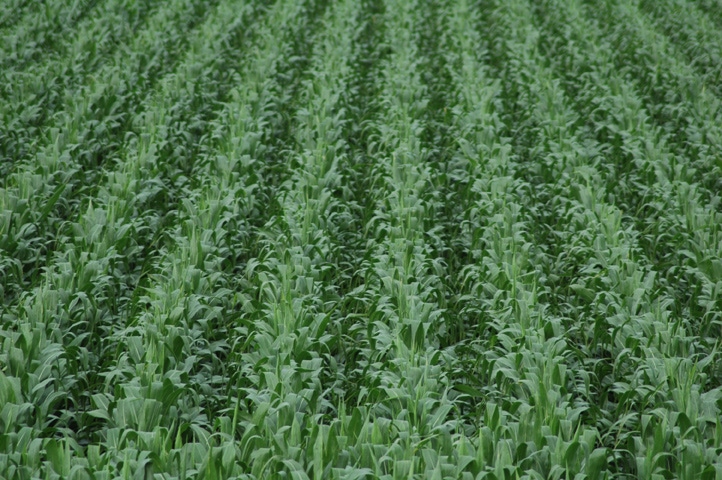July 17, 2013

Corn prices and soybean prices and markets continue to reflect uncertainty about the potential size of the 2013 U.S. corn and soybean crops. Over the past month, December 2013 corn futures have traded in an 80¢ range, and November 2013 soybean futures have traded in a $1 range as production expectations shifted up and down. Uncertainty about both acreage and yield prospects has contributed to the relatively wide trading range, according to University of Illinois Agricultural Economist Darrel Good
“The USDA’s June Acreage Report showed that producers planted, or intended to plant, slightly more acres of both corn and soybeans than indicated in the March Prospective Plantings report,” says Good. “The report also showed that the difference between planted acreage and expected harvested acreage of corn for grain was larger than average at 8.244 million acres. On the other hand, the expected difference between planted and harvested acreage of soybeans was smaller than average at 810,000 acres.”
Additional information about the likely level of planted and harvested acreage will continue to be available to the market. The USDA indicates it will resurvey soybean acreage in 14 states during July and reflect any changes in the August Crop Production report. Some additional acreage information for both corn and soybeans may also become available through the normal survey process for the August, September, October and November production reports. Certified acreage data from the Farm Service Agency (FSA) will also become available and should be reflected in the USDA’s October production report.
Another source of information about the magnitude of planted acreage will be available with the FSA reports of prevented planted acreage. Preliminary estimates are expected next month.
“The estimates of prevented planting are reported by crop and by state and will be used to judge the potential change between the June acreage estimates and actual planted acreage,” Good says. “The problem with using that information, however, is that there has been only a loose relationship between the magnitude of total prevented planted acreage and the difference between actual plantings and the June acreage estimate. In recent history, the largest prevented planted acreage occurred in 2011, when 9.6 million acres of all crops were reported as prevented planting. Prevented plantings of corn were reported at 3 million acres, but total planted acreage of corn was only 346,000 less than the June acreage estimate.
“Similarly, prevented plantings of soybeans were reported at 1.45 million acres, but actual planted acreage of soybeans was only 162,000 less than the June acreage estimate,” Good says. “For 2009 and 2010, when prevented planted acreage was also large, the relationship between the magnitude of prevented plantings and the difference between actual acreage and the June estimate was only close for soybeans in 2010. For corn, actual acreage in 2010 exceeded June intentions by 320,000 acres even though prevented plantings were reported at 2.1 million acres.”
Given the lateness of the 2013 planting season, reported prevented planted acreage is likely to be large, Good says. In addition, some planted acreage has been lost to flooding. As a result, actual planted and harvested acreage of both corn and soybeans are likely to be less than the June estimates. The magnitude of the difference, however, may remain uncertain until October.
Good says that the same factors that have created uncertainty about planted and harvested acreage of corn and soybeans have also contributed to early-season yield uncertainty.
Like what you're reading? Subscribe to CSD Extra and get the latest news right to your inbox!
“Judging from current crop condition ratings, yield prospects at this stage of the growing season are quite good,” he says. “However, overall yield prospects will be influenced less by developments to date and more by weather conditions over the next two months as the crops go through the reproductive and filling stages. Recent weather and near-term weather prospects are a bit of a mixed bag with almost ideal moisture conditions in many areas, but too much rainfall in some areas, dryness developing in some western areas and generally above-average temperatures this week. As usual, there are some differences of opinion about longer-term weather forecasts. Prospects for moderating temperatures and thunderstorm activity, however, bode well for yield prospects. The markets will continue to monitor crop condition ratings for indications of yield potential,” Good says.
Good concludes that even with harvested acreage less than currently estimated, prospects for corn and soybean yields near trend value in 2013 point to large crops and the likely buildup in stocks during the 2013-2014 marketing year.
“Due to the extreme lateness of soybean planting in some western and northern growing areas, soybean yields may be at more risk than corn yields,” Good says. “Soybean yield uncertainty could persist later in the season than is normally the case, with new-crop soybean futures reflecting more production risk than new-crop corn futures.”
You might also like:
PHOTOS: Signs of Spring Flooding Remain in Corn, Soybean Fields
VIDEO: NRCS on Watersheds, Water Quality, Conservation Investment
You May Also Like




